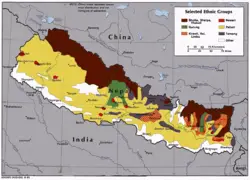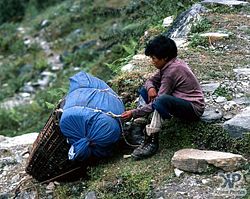Sherpa
The Sherpa are an ethnic group from the most mountainous region of Nepal, high in the Himalaya. In Tibetan shar means East; pa is a suffix meaning 'people': hence the word sharpa or Sherpa. Sherpas migrated from eastern Tibet to Nepal within the last 500 years, sometime in the early 1400s. A female sherpa is known as a "sherpani."
The term 'sherpa' (the preferred spelling with a lower case first letter) is also used to refer to local people, typically men, employed as porters or guides for mountaineering expeditions in the Himalayas. It's literal translation is easterner, referring to their origins in Eastern Tibet. The Sherpa are highly regarded as experts in mountaineering and their local terrain, as well as having good physical endurance and resilience to high altitude conditions. However, a sherpa is not necessarily a member of the Sherpa ethnic group.
History
Most Sherpas live in the eastern regions of Nepal Solu, Khumbu or Pharak. However, some live farther west in the Rolwaling valley and in the Helambu region north of Kathmandu. Pangboche is the Sherpas' oldest village in Nepal, and is estimated to have been built over 300 years ago. Sherpas speak their own Sherpa language which in many ways resembles a dialect of Tibetan. They traditionally are traders and farmers, cultivating their high altitude fields of potatoes, barley, wheat and buckwheat. Some live near Namche Bazaar. The Jirels, native people of Jiri, are ethnically related to the Sherpas. It is said that the Jirels are descendants of a Sherpa mother and Sunuwar (another ethnic group of the eastern part of Nepal) father. In India, Sherpas also inhabit the towns of Darjeeling and Kalimpong and the Indian state of Sikkim. The 2001 Nepal Census recorded 154,622 Sherpas in that country, of which 92.83% were Buddhists, 6.26% were Hindus, 0.63% were Christians and 0.20% were Bön.
Traditionally (although not strictly followed), the names of Sherpa men often reflect the day of the week on which they were born:
| English | Sherpa |
|---|---|
| Sunday | Ngi`ma (Ng' is the phoneme / ŋ /.) |
| Monday | Dawa |
| Tuesday | Mingma |
| Wednesday | Lhakpa |
| Thursday | Phurba |
| Friday | Pasang |
| Saturday | Pemba |
Sherpas have been the pride of Nepal, and the hope for the future. The Sherpas contribute substantially to the economic growth and stability of Nepal.
Culture
Sherpas were of immeasurable value to early explorers of the Himalayan region, serving as guides and porters at the extreme altitudes of the peaks and passes in the region. Today, the term is used casually to refer to almost any guide or porter hired for mountaineering expeditions in the Himalayas. However, in Nepal Sherpas insist on making the distinction between themselves and general porters, as they often serve in a more guide-like role and command higher pay and respect from the community. (Often the generic term "sherpa" meaning guide is written uncapitalized, in contrast with the capitalized "Sherpa" meaning the ethnic group.)
Sherpas are renowned in the international climbing and mountaineering community for their hardiness, expertise, and experience at high altitudes. Many have speculated that a portion of Sherpas' climbing ability may be due to a genetically greater lung capacity, allowing much better performance at high altitudes. It has also been suggested that one reason why they were widely used as porters is that they had fewer dietary prohibitions than most people of the region and were prepared to eat whatever was given to them on expeditions.
The reputation of the Sherpa as world-class climbers is widely known. Local cultural traditions have nurtured a very close relationship with westerners and western thought. These mountain folk are known the world over for their hospitality of western people.
With the first Mt. Everest expedition in 1921, English mountain climbers were highly impressed with the skill and endurance of the local Sherpa people. The affinity between the westerners and the Sherpa civilization grew amicably into a close sharing and understanding between vastly different cultures. Mutual friendship for example can be seen in the adaptation of the Texas-style boots and cowboy hats which the Sherpa have integrated into their native garb, as a substitute for traditional Sherpa attire. Simultaneously, Buddhist prayer flags adorn western encampments.
Before the influx of western influence, the Sherpas revered the Himilayas as a dwelling place of the gods and goddesses. For centuries, the very thought of climbing them was considered a blasphemy against the supernatural beings. Chomolungma is the Tibetan name for Mt. Everest, and is the dwelling place of Miyo Lungsungama, the goddess of humans and prosperity. When the Swedes, Germans, and Brittish first arrived at Mt. Everest, the allure of mountain-climbing for fame and monetary profit became of great appeal to the Sherpa, and they were highly praised and duly rewarded for their touchstone of high-altitude achievement. This was a radical shift in traditional culture, as the Sherpa had always maintained roles as traders and farmers, heavily emphasising their peaceful religious practices. The ancestral roles remain highly important to these mountain folk, but the climbing industry has become the staple of their economy.
Sherpa culture is vastly different from the other 50 ethnic groups of Nepal, including Hindus, Muslims and Buddhists. Throughout much of Nepal, Hindu and Buddhist doctrine has often meshed into a single ideology, whereas the Sherpa have adapted their beliefs from a series of different schools of thought, which has evolved over the centuries.
Sherpa Religion
Sherpa religion is a mixture of Buddhism and Animism, and their culture has evolved from thousands of years of myths, stories and fervent religious ritual. The dogma of Sherpa Buddhism teach of a spiritual understanding between all beings. This explains why the hospitality and open acceptance of westerners is such a natural aspect of the Sherpa culture. Although they are pacifists, the Sherpa of Tibet are also known to be among the fiercest warriors. The guardian deity of the Sherpa is named Khumbu, which literally translates into "Khumbu country god."
Buddhism is known to be a very open and accepting school of thought. There is a famous story of Swedish missionaries travelling to Tibet as it opened to the west, in which the Tibetans openly embraced tales from the bible, listening with intense intellectualism, questioning and debating amongst themselves. Although they were not converted, when the Tibetans were later questioned about their first encounter with the Christian missionaries, they responded with something to the effect of the missionaries being wonderful story-tellers. The Sherpa hungrily digest any and all tales and stories, and their oral traditions are passed on through the generations.
Famous Sherpas
The most famous Sherpa is Tenzing Norgay, who climbed Mount Everest with Edmund Hillary for the first time in 1953. Tenzing and Hillary were the first people to conclusively set their feet on the summit of Mount Everest, but journalists were persistently repeating the question which of the two men had the right to the glory of being the first one, and who was merely the second, the follower. Tenzing stressed the unity of such teams and of their achievements. He shrugged off the allegation of ever being pulled by anyone, but disclosed that Hillary was the first to put his foot on the summit. He concluded: "If it is a shame to be the second man on Mount Everest, then I will have to live with this shame."[1]
Two Sherpas, Pemba Dorjie and Lhakpa Gelu, have recently competed as to who can climb Everest from Basecamp quicker. On May 23 2003 Dorjie summitted in 12 hours and 46 minutes. Three days later, Gelu beat his record by two hours, summitting in 10 hours 46 minutes. On May 21 2004 Dorjie again improved the record by more than two hours with a total time of 8 hours and 10 minutes.[2]
On May 16 2007, Appa Sherpa successfully climbed Mt. Everest for the 17th time, breaking his own record for most successful ascents.[3]
Perhaps the most famous Nepalese female mountaineer, two-time Everest summiteer Pemba Doma Sherpa, died after falling from Lhotse on 22 May 2007.[4]
Notes
- ↑ Tenzing Norgay and James Ramsey Ullman, Man of Everest (1955, also published as Tiger of the Snows)
- ↑ New Everest Speed Record upheld. EverestNews.com. Retrieved Feb 4, 2007.
- ↑ Super sherpa's new Everest record. BBC News (May 16, 2007). Retrieved May 16, 2007.
- ↑ "Famous female Nepal climber dead", BBC News, 23 May 2007
ReferencesISBN links support NWE through referral fees
- Norgay, Tenzing and James Ramsey Ullman. [1955] 2007. Man of Everest (also published as Tiger of the Snows) Gibson Square Books Ltd. ISBN 978-1903933312
- Ortner, Sherry B. 2001. Life and Death on Mt. Everest: Sherpas and Himalayan Mountaineering. Princeton University Press. ISBN 978-0691074481
- Tinzing, Judy, 2003, Tenzing and the Sherpas of Everest. Harper Collins e-books. ASIN B000FC143A
External links
- Website on the Sherpas of Nepal
- Website of United Sherpa Association in New York
- News: Sherpa breaks Mt Everest record - BBC
Credits
New World Encyclopedia writers and editors rewrote and completed the Wikipedia article in accordance with New World Encyclopedia standards. This article abides by terms of the Creative Commons CC-by-sa 3.0 License (CC-by-sa), which may be used and disseminated with proper attribution. Credit is due under the terms of this license that can reference both the New World Encyclopedia contributors and the selfless volunteer contributors of the Wikimedia Foundation. To cite this article click here for a list of acceptable citing formats.The history of earlier contributions by wikipedians is accessible to researchers here:
The history of this article since it was imported to New World Encyclopedia:
Note: Some restrictions may apply to use of individual images which are separately licensed.



